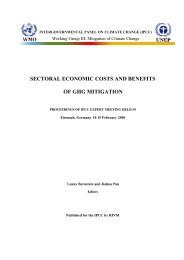Pacific Islands Environment Outlook - UNEP
Pacific Islands Environment Outlook - UNEP
Pacific Islands Environment Outlook - UNEP
You also want an ePaper? Increase the reach of your titles
YUMPU automatically turns print PDFs into web optimized ePapers that Google loves.
56<br />
EMERGING ISSUES<br />
●<br />
an internalization of all costs, including the cost of<br />
managing these risks.<br />
It follows that environmental advisers to governments of<br />
the region will need ‘a seat at the table’ when significant<br />
investment decisions are being evaluated. Another<br />
emerging issue therefore revolves around the choice of<br />
public sector mechanisms to achieve this in PICs.<br />
Adaptation to climate change<br />
As outlined in the ‘Atmosphere’ section in Chapter One,<br />
the need to take measures to adapt to climate change<br />
appears inevitable for PICs. These measures will need<br />
to address the frequency and intensity of extreme<br />
events, as well as the effect on PICs of sea-level rise –<br />
even at the lower end of the prevailing estimates for the<br />
next century.<br />
Some of the possible effects of climate change and<br />
sea-level rise that are expected in PICs are noted in<br />
Table 4.1.<br />
There are, however, a number of local actions that<br />
could minimize these negative impacts of climate change<br />
and sea-level rise, should they occur. Improving the<br />
management of natural coastal systems such as coastal<br />
forests, mangroves, beaches, reefs and lagoons, the<br />
careful planning of coastal zone developments, and the<br />
construction of coastal defences such as sea-walls to<br />
protect particularly valuable and vulnerable sites, are all<br />
actions that can be implemented now.<br />
Adaptation strategies will not be cost-free. There<br />
are, however, ways in which they can be linked to other<br />
investments that need to be made and to other<br />
environmental objectives discussed elsewhere in this<br />
report. In other words, an adaptation strategy that is<br />
planned for implementation over 30–50 years will<br />
impose lower costs than one that has to be handled in a<br />
five-year period.<br />
Particular emphasis will need to be placed on<br />
development policies, programmes, plans and projects to<br />
ensure they take into account the likely effects of climate<br />
change and incorporate adaptation as necessary. This is<br />
Table 4.1: Indicative list of potential impacts of climate change and sea-level rise requiring adaptive<br />
responses in PICs<br />
Coastal zone ● Inundation and flooding of low-lying areas<br />
●<br />
●<br />
Coastal erosion<br />
Possible increase in cyclone-related effects<br />
● Changes in sediment production due to changes in coral reef systems<br />
Water resources ● Changes in freshwater lenses and other groundwater resources<br />
● Salt intrusion of groundwater resources<br />
● Changes in surface-water resources<br />
● Changes in surface run-off, flooding and erosion<br />
Agriculture ● Changes in commercial crop yields<br />
● Changes in subsistence crop yields<br />
● Changes in plant pest populations<br />
● Possible changes associated with changes in ENSO, drought and cyclone patterns<br />
● Changes in soil quality<br />
Fisheries ● Changes in distribution and abundance of offshore fish species<br />
● Changes in productivity of inshore fisheries<br />
● Changes in fish breeding sites<br />
Ecosystems ● Coral bleaching and coral degradation (also possible increased upward coral growth)<br />
● Changes in mangrove health and distribution<br />
● Degradation of sea grass meadows<br />
● Changes in forest ecosystems<br />
● Changes in wetland systems<br />
Human health ● Increased incidence of vector-borne diseases such as malaria and dengue fever<br />
● Increased heat stress and heat-related illnesses<br />
● Indirect effects on nutrition and well-being secondary to effects in other sectors, such as agriculture and water resources<br />
● Deaths, injuries and disease outbreaks related to possible increases in extreme events such as cyclones, floods and droughts<br />
Source: SPREP 1999c

















